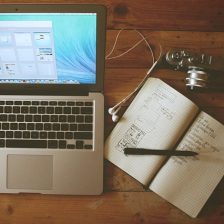Audacity Quick Start Guide
Audacity is an excellent sound recording and editing application. Even as a free product, it rivals many of the paid products that my band has tried over the years. Audacity’s price tag, ease of use, and powerful capabilities make it our app of choice for working on songs remotely.
If you don’t have it already, you can download it here.
When you launch the application for the first time, you get a pretty good welcome menu with instructions on how to do common tasks.
You can explore the menu system or proceed through this document for specific steps. Click OK to start using Audacity.
Record Voice or Instrument
Make sure you connect a mic or instrument to the appropriate Line-In jack on your computer before continuing. You may need to go into control panel to configure your soundcard and/or inputs. Once you can hear your voice or instrument through the computer speakers, you are ready to go.
If you’d like to make sure Audacity is capturing your sound, click the drop-down arrow next to the microphone icon and select Start Monitoring.
Make noise or strum your guitar and you’ll see the meter bounce with you. You can adjust volumes with some of the other sliders on the top bar if necessary.
When you are ready to begin recording, click the record button: 
When you are done, click the stop button: 
You should see your recording in the track window:
Now that you have the recording, you can use the buttons to play, rewind, etc. There are a few effects you can add to spice it up a bit if you aren’t using a pedal or other settings on your amp to get your sound.
If you want to delete the track, click in it and hit the Delete key, or click the X in the upper-left of the track control panel:
Saving and Converting to a Playable format (such as MP3)
You usually want to save your work as a project file in Audacity so that you can come back to the source and make changes in the future. It also makes a convenient way to share your tracks with others in a small file format that they can import rather than sending larger MP3 files around.
To save in Audacity Project format, click File > Save Project As…
Make sure the Save as type: field shows *.aup. Browse to a location to save the file to and give it a name.
Click Save to make it happen:
If you want to save the file in a format playable outside of Audacity (MP3, WAV, WMA, etc), you need to Export the file.
Click File > Export…
Select the desired file type by using the Save as type: button.
The options currently available are:
Once you get the file type squared away, browse to a location to save the file to and give it a name.
Click Save to make it happen:
Once you click Save, you will be able to enter Metadata for the track. Fill in what you want and click OK to build the sound file.
Importing a File
If you get an Audacity project file (*.aup) from someone else, it is very easy to open it on your PC. You can use the same process for importing any other supported file for editing.
Simply click File > Open and browse to the file you want.
If you import a *.aup file, you can Export it from there to create an MP3 or other type of portable music file.
If you import a music file such as an MP3 or WAV, you can Save Project As… to save a much smaller version of the file in *.aup project file format.
Editing Tracks
Audacity is a powerful tool and you can do a lot with a project file or an actual sound file. For example, you can merge two or MP3’s, cut out specific parts from a song to make a new sound file, and even create loops.
When you record yourself, you will commonly want to get rid of certain parts of the recording. Whether it is lead-in and/or lead-out whitespace or a part you messed up elsewhere during the recording, you can use the mouse to highlight and cut sections. You can also move sections closer or farther apart from each other to blend sounds better.
In the following example, I want to get rid of the dead space that occurred between the time I hit record and actually started playing, as well as the dead space at the end of the song that recorded while I was getting to the stop button. The sections we will delete are in the red circles below:
Just position your mouse inside the track area and click and drag the area you want to get rid of. The track will change to a darker color and you will be able to visually see what you are about to delete:
Hit the Delete key to delete the highlighted section of the song:
Next, we’ll strip the space at the end of the song, and the finished product now looks like this:
Much better….
This should get you started. Use the included help file and when it doubt, Google your Audacity questions. Google is a great resource because the Audacity help files really aren’t that complete.


















